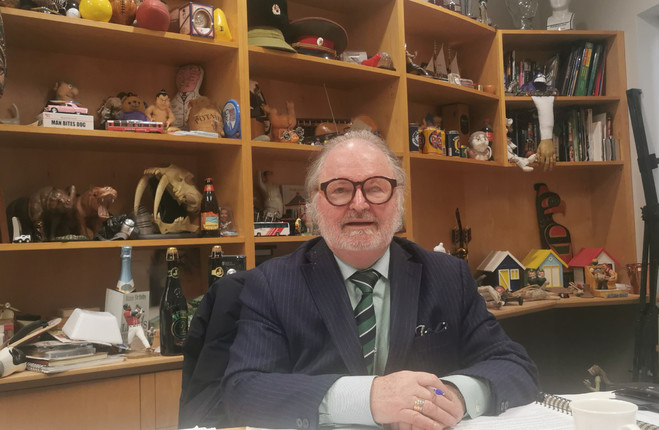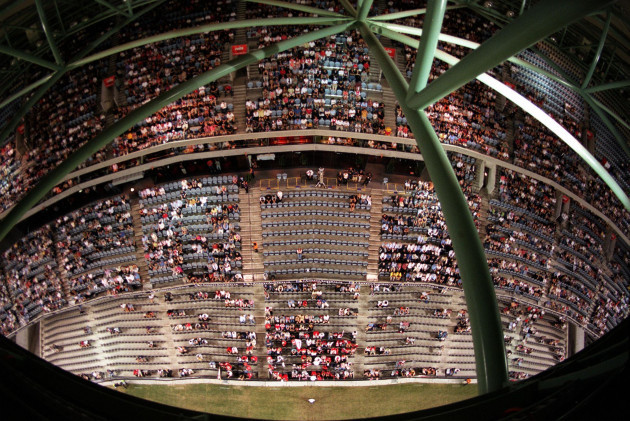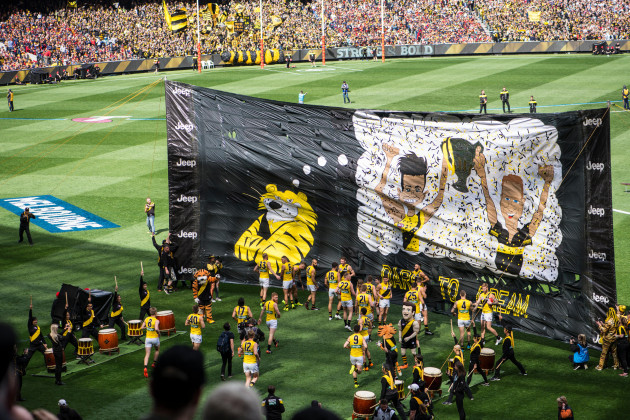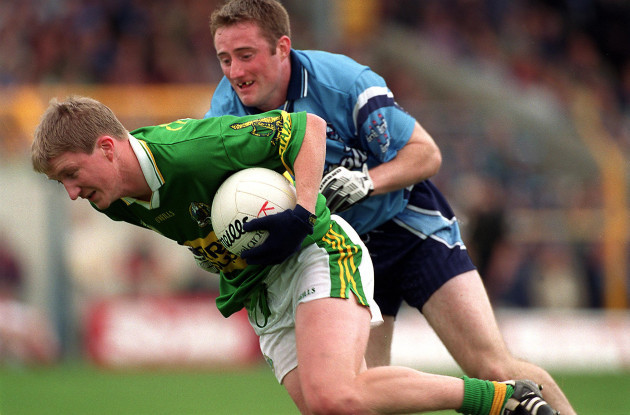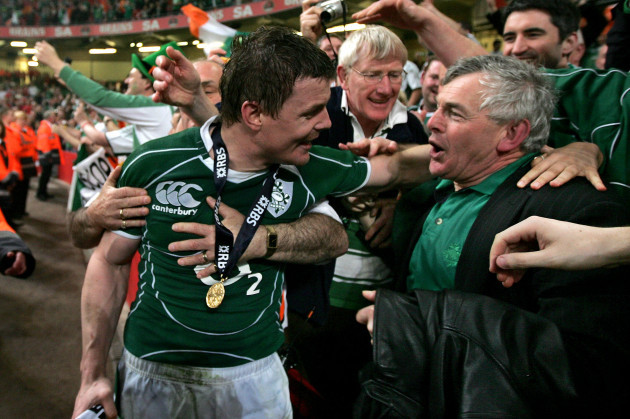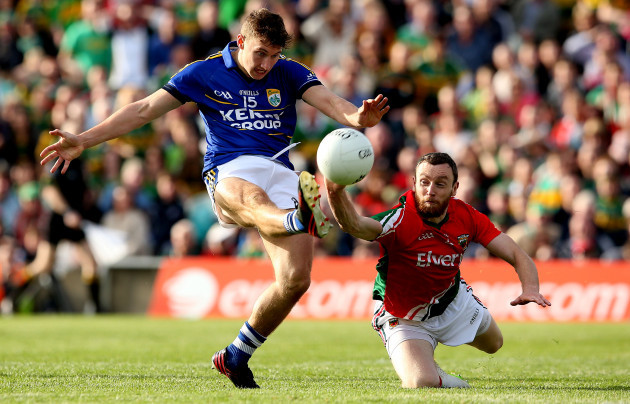MARADONA, ROY KEANE, Pele, Ronaldo and the Australian 2006 World Cup squad are together in one room. Peter Jess strolls around his office building and pauses in front of their signed jerseys and photographs. A personal sports museum and memorabilia haven, dedicated to his lengthy list of past clients and partnerships.
Sonia O’Sullivan’s bib from her 1999 world record at Loughrea hangs alongside Usain Bolt’s kit in another room. The iconic Nicky Winwar photo takes centre stage in the hallway: “To Peter, black and proud, Nicky.”
Aussie Rules is a sport that has dominated his social and working life. Step inside the front door and you are greeted by a framed jersey with a touching note from Chris Judd, widely regarded as one of the best players in the history of the modern game.
His portfolio of players within the league has diminished in recent years but his involvement continues unabated. Jess is a man on a mission. He has become the public face for former players and a leading advocate for concussion prevention. The agitator in chief for the top brass.
“I am their worst enemy,” he declares.
It is a name that should ring familiar on Irish shores. After Ron Barassi started the ‘Irish experiment’ by bringing Gaelic footballers to Australia, Peter Jess tried to revive it. The process had all but lapsed in the mid-90s. Around the same time, Jess approached Ireland-based financial services company Fexco with a business proposition around Australian prize bonds and body corporate services.
During a visit to Ireland, he encountered some high-profile folk from Kerry GAA. They extended an invitation to visit Killorglin for a training session. On the field he saw possibilities. Opportunities.
He was convinced various young prospects had what it takes to make it Down Under. Gaelic football could help AFL. Now, he thinks it could save it.
“GAA to me was the perfect example of how football can remain community-based,” he explains.
“So, the debate at the time was around Australia moving to the American module, club franchises. That disengaged the local community.
“I loved the Irish model. I also wanted to recruit Irish players to experience the AFL way of life. Making them full-time professional rather than part-time.”
His involvement in the industry started when his cousin, Jim Jess, joined Richmond in 1980. Agents were a foreign concept at the time. Nevertheless, when the offer of $10,000 plus match fees came, something felt unfair.
Jim discussed it with his cousin. Peter took it upon himself to negotiate. They wanted $100,000 with no strings. Plus, $10,000 for use of image fees. The paradigm was tilted on its head.
From that moment on, the player was his priority. They should be rewarded. Protected. The only way to do it was with a thorough, transparent process. That wasn’t a welcomed strain of thinking when he looked abroad.
“Shamatuerism was rife in Ireland. You pretend you weren’t receiving anything, but you had jobs arranged. Sponsors sorted. It was like Irish dancing with the half doors. The bottom half of the door is shut, and nobody can see you dancing, but you were.
“I was interested in giving people a pathway to explore their full potential in an indigenous game. When you cross-pollinate you bring back ideas. It improves both games. The Irish gave us a great lesson in running football. We gave them a lesson in fitness and the tackle. The marrying of two codes was a match made in heaven for me.”
By the noughties, Jess had developed a proposal to formalise the arrangement. At this stage, scouts were attending Gaelic football games regularly. It was covert; discussions and offers conducted in the shadows.
The idea was an academy that included a player exchange programme. In doing so, both bodies could create a pathway, give rookies the best chance at success while capping the numbers. Clubs like Richmond and West Coast Eagles were on board and even began identifying players who could be sent to Ireland.
Meanwhile, Jess met with UCD’s Brian Mullins to build a base on the other side. Then the games began. He went directly to the GAA and sat down with president Nickey Brennan. That day, the dream died.
Ball burst, go home.
“It went to shite quickly. I tried with Brian Mullins to set up a joint academy with GAA and AFL. We could give them basic skillsets, proficient in punting, handball, the drills that would be replicated in training in Australia.
“I found the GAA territorial and parochial. They could not take the next step to globalisation and thought they would be consumed as a subsidiary of AFL clubs and lose their local identity.”
Soon after he sold the Fexco shareholding. There was no longer a need to travel for board meetings. Be that as it may, the success of his initial contenders opened the eyes of other AFL agents. It became a gold rush.
Jess still has all his correspondence from this era. His office hosts meticulous records. When detractors inevitably take aim at his boisterous approach, he returns fire with a barrage of facts and figures.
The proposal’s failure meant the secretive scouting system continued. Former Irish AFL players were employed to identify talent. Scouts and list managers flew in and out routinely. Many teenagers were approached, several went.
His initial venture to the Kingdom was particularly fruitful. Jess’s network held discussions with a promising teenager by the name of Tadhg Kennelly. That move proved successful. The other one didn’t. It is not a regret, however, there is a lingering sense of what might have been.
When Jess showed clubs footage of Mike Frank Russell, their eyes lit up.
“He would have been a star in Australia. But he had a fear of the unknown, he really was a Kerry boy through and through.
“He had to have a quantum leap in faith. He came over and I took him around and showed him the stadiums. He just said: ‘At the end of the day I am from Kerry.’ He wanted to play in an All-Ireland, be part of the Kingdom’s worshipped players.”
His relationship with this isle started lifetimes ago. Family lineage that can be traced back to Limerick. Jess’ five times removed great grandfather, Jeffrey, was born there. Jeffrey’s son, Tom, left for Liverpool during the famine. With 13 kids in tow, he sailed from there to Australia, docking in Portland on the south coast.
That has always formed part of who he is and what he does. Unashamedly. After the Good Friday agreement, the ban on Sinn Féin personnel visiting Australia was lifted. Jess was amongst the first to greet Gerry Adams and Martin McGuinness at the Celtic Club as part of the Casement Group when they arrived for a speaking tour.
This is a theme. Passionate about what he believes in. Ever willing to challenge authority when necessary. Unyielding.
In the lobby, high-profile former AFL players wait to go over financial matters.
Concussion awareness is at the forefront of his mind, at the front of a long queue.
On the desk lies a thick folder. He opens it to reveal a comprehensive analysis of Wallaby out-half Bernard Foley and winger Reece Hodge. The amount of exposure they generate for their commercial sponsors is graphed to decimal point precision. Each revenue stream mapped out to form an irrefutable reference point during negotiations.
It is his long-held view that players’ image rights are misunderstood and undervalued.
In the past, he did something similar for Irish players, including Brian O’Driscoll. In doing so he got to know the Irish rugby star’s father, Frank, and uncle, Barry. Both of them were doctors. Jess had a concern he wanted advice on.
The relationship between agent and players is paternal. It is a road that starts with teenagers, fit and healthy, ready to take on a professional journey. Ideally, it will include many highs. Usually, they encounter several lows. Rewards and reckonings.
This merely highlights the weight of responsibility for the agent. Someone who has the power to do a whole lot of good. Or bad.
At the turn of the century, Jess started to notice something amongst his older clients. Before his eyes, he saw them go from healthy to distressed. Retired players who suddenly appeared “clattered”. Walking wounded.
Their symptoms struck a note with his own personal experiences after two serious motor accidents. Four pillars form the basis of this concern: changes in mood, behaviour, cognition and motor skills. Research led him to America and further afield. The realisation that it was related to chronic traumatic encephalopathy (CTE) hit him like icy wind.
Then he went directly to the AFL.
“First, they said it is unique to America. I said no, it is not. We need to look at the science. The brain does not know where it is, it just knows it has been clattered. Your brain is in a fixed encasement, your skull. It gets sloshed around with a sling tackle. The first thing I got them to do was change the rules around returning players who had been concussed but could play on the same day.
“They stopped that. Then, I got them to change return to play from six days to 12. But it is not enough. I am still at them.”
Jess helped former AFL player Shaun Smith secure a landmark decision for concussion in sport in 2020. The former Melbourne and North Melbourne player was awarded a AU$1.8m insurance pay out after he suffered “total and permanent disablement” due to head knocks during his career.
In the aftermath, the AFL were adamant the health and safety of all players was paramount. They highlighted changes to match day protocols, laws around high contact and return to play protocol as steps toward resolving the issue.
For Jess, it is not nearly enough.
“I think they do not appropriately care about players. They are a commodity. They are simply a commodity. If they took it upon themselves to act like good corporate citizens, I would not have to fight in the courts to get guys justice.
“For me, it is simple. They were specifically excluded from workers compensation by a private members bill. So, they have no workers compensation. We are the only first-world country in the world with a professional sport where you do not have workers compensation.
“I have been fighting for that for 30 years. I have been able to get some change, but it is just bits and pieces. Not the spectrum needed.
“That is why I am arguing that we need to set up a separate fund to take care of all the guys who have long-term neurological damage, long-term orthopaedic damage and long-term dental damage from playing the sport.
“They are in a workplace. Imagine an incident like that in a workplace and thinking it is safe. It is not. It is nuts. This is what I am saying, a football ground is an industrial worksite. You get an industrial disease from playing it.
“If you get an industrial disease, it comes down to when did the employers know and what have they done about it. The AFL have performed Irish dancing for the last 25 years. They shut the bottom door and jumped up and down, pretending they were not dancing when in fact they are.
“What I am saying to you is the AFL sits there with its eyes wide shut. I am not going to let them think they can get away with it. They have to change the rules. I am perpetually writing to them. I have 12 spring back binders to the AFL since I first started my campaign on concussion. I think I have gotten a response three or four times.”
Over the past two decades, he has systematically researched this topic. Consulting the likes of the Boston Medical Centre, Dr. Chris Nowinski of the Concussion Legacy Foundation and Dr Willie Stewart, the world’s foremost expert on the link between football and brain injury-related deaths.
His campaign has several strands, strategies he wants adopted to respond to players who have been damaged and protect the future. For example, Jess has proposed a betting levy. Gambling advertising is extremely prominent within the code and currently a billion-dollar industry.
This occurs with “no significant contribution to the players who are damaged creating the betting medium”.
Jess has also pushed hard for clubs to scan every player for concussion on a prospective basis. Last October, Carlton confirmed they were working through the idea to become the first club to do so.
His recent research has taken him back to Irish shores. His current aspiration is to see both codes become even more similar.
“Gaelic football can be the saviour of the AFL. Simply, we stop our tackle. We bring in their block.”
Ever since 2008 when they outlawed the sling tackle, the AFL commission has routinely tweaked their tackle guidelines in an attempt to protect players’ heads.
Darragh Joyce has been subbed out of #AFLCatsSaints following this incident.
— AFL (@AFL) August 14, 2021
He is replaced by Oscar Clavarino. pic.twitter.com/AQkEEs8cpC
“Look, the game originally manifested as an outlet for violence amongst men. What happens was someone decided to throw a ball in and call it a game. But they used to meet at parks and clatter each other. Someone decided to call it a sport and went round saying this is an oval, we play here, and you can do all these antisocial activities like punch each other and not go to prison.
“’This is sport.’ No, it’s not. When you get the suitcase kicked out of you on a field, that is not sport. It’s violence. That is violence in a very basic form. We need an education. If you want to have pure sport, let’s have pure sport.”
Inevitably, such drastic change has already proven divisive. His consistent response is that the sport will gain far more than it currently risks losing.
“There is plenty of physicality in Gaelic football. However, it is controlled and modified. We don’t have a modified version in AFL. There is a 360 tackle. Swung, clobbered, tackled from every angle. The biggest issue we have in football is the diffuse brain trauma. That is from sling tackles.
“Unless you go to the molecule level you will not find the true extent of the damage. That is why I say we are not doing enough testing. We are not doing enough testing in the right modalities.
“I am doing a comparative analysis of the concussions per playing hour in GAA men’s and women’s, versus the concussion in Aussie Rules. That gives me the science and the template to go to the AFL and say, ‘we need to fundamentally change our game to make it safe.’ Based on the evidence I present; we can see by GAA what a safer game looks like if we modify the AFL.”
Right now, his research scientists are trawling through published statistics from the GAA and medical conferences. Then he will bring it all to the AFL and go toe-to-toe once again.
“What we find is on average in the two-hour period players play, they have 80 collisions. Some of which are at 8gs force or more. That is a car crash at 45ks an hour. Doesn’t kill you but it hurts you.
“If we don’t change, we won’t have a game. Medicine and science tell us there is no good knock to the head. There is no good knock to the head of men, women and children. This can not continue.”
